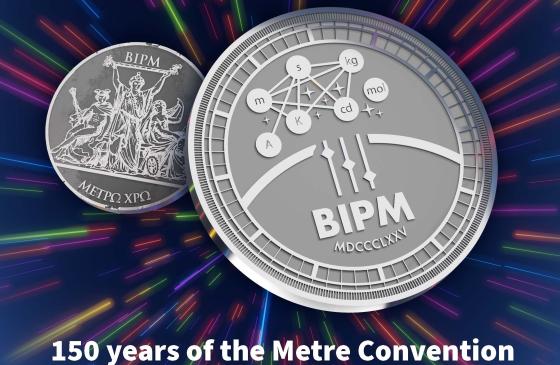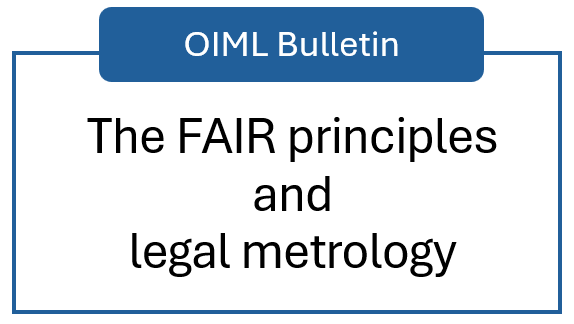OIML BULLETIN - VOLUME LXVI - NUMBER 3 - July 2025
e v o l u t i o n
Digital transformation in legal metrology
Insights from the OIML DTG Survey 2024
Sascha Eichstädt 1, Katya Delak
2, and Catharina Kulka-Peschke
1
1. PTB , Braunschweig, Germany
2. NIST , Gaithersburg, United States
Citation: S. Eichstädt et al. 2025 OIML Bulletin LXVI(3) 20250307
Abstract
Recognizing the significance of digitalization, the OIML Digitalisation Task Group (DTG) conducted a survey in 2024 to assess the current state, challenges, and future potential of digitalization in legal metrology. The survey 2024 followed the OIML Seminar held in 2023 in Chiang Mai, Thailand. With responses from over 100 individuals representing CIML Members, OIML-CS utilizers, OIML TCs, SCs and PGs, and several others, the survey provides valuable insights into the digital transformation of legal metrology.
The questions of the survey are here categorized in three sections: (1) digitalization and digital literacy; (2) challenges and barriers; (3) potential of digitalization. Moreover, the DTG subcommittees “Smart OIML documents” and “e-Learning” provide a synthesis of the survey outcomes from their perspectives.
State of Digitalization and Competencies
The survey contained questions related to the self-assessment of the respondents and on their perception of the OIML. Regarding the self-assessment, the respondents perceived their main competence more in laboratory automation and less in machine-to-machine communication or machine-readable standards. Overall, the respondents assessed their digital competence between 2-3 on average on a scale of 0-5 with 0 meaning no knowledge at all, and 5 meaning digital expert knowledge.
The results indicate a wide disparity in the level of digitalization among OIML members. While especially stakeholders appear to have high digital competence and extensive experience with modern technologies, others, particularly in less developed regions, require fundamental training. Many respondents to the Survey recognized the need for significant improvements, particularly in implementing digital technologies and harmonizing standards across jurisdictions.
Specific inputs from the Survey emphasize that there is a lack of clear roadmaps for digital transformation, whereas some respondents articulate concrete needs such as automation of laboratory processes to improve efficiency and facilitate data collection. One respondent suggested that the OIML should lead the digitization of legal metrology semantics to ensure consistency and proper interpretation of metrological data.
Challenges and Barriers
According to the respondents to the Survey, several challenges and barriers hinder the seamless adoption of digitalization in legal metrology:
- Technical Issues: A lack of appropriate infrastructure, interoperability problems, and high implementation costs pose significant obstacles to digital adoption.
- Acceptance and Resistance: Many regions still rely on traditional paper-based systems, leading to resistance to change.
- Data Security and Privacy: Security concerns related to digital documents and systems remain a critical issue.
- Inequalities: Varying levels of development among member countries make it difficult to introduce unified digital solutions, further complicating harmonization efforts.
Additionally, respondents noted that the digital competence within OIML varies significantly, with some stakeholders requiring extensive training. The need for structured digital education and awareness programs was repeatedly emphasized. Some participants noted that despite OIML's digital initiatives, there is still an absence of concrete, standardized digital tools available to members.
To harness the benefits of digitalization while addressing existing barriers, respondents suggest several key measures:
- Education and Training: Development of e-learning material, seminars, and workshops tailored to the specific needs of OIML Members to help building digital competence.
- Development of Digital Tools: Provision of machine-readable standards, digital test reports, and centralized databases to facilitate the transition to digital systems.
- Gradual Implementation: A phased approach, starting with simple, well-functioning tools before introducing more complex systems to ensure smoother adoption.
- Promoting Collaboration: Encouraging knowledge-sharing, joint projects, and industry participation can enhance digitalization efforts and foster best practices.
Potential of Digitalization
Despite these challenges, the Survey highlights the vast potential of digitalization in legal metrology. Digital platforms can significantly enhance efficiency, for example, through the digitalization of conformity certificates under the OIML Certification System (OIML-CS). Moreover, digital tools can improve traceability and automate processes, leading to more reliable and transparent metrological operations. The survey also underscores the importance of international harmonization, advocating for better integration with existing standards through collaboration with organizations such as ISO and IEC.
Further examples provided in the Survey indicate that automation of laboratories, digital test reports, and smart standards could revolutionize the efficiency and accessibility of legal metrology services. One proposal mentioned the development of a centralized certificate database to improve conformity assessments and global recognition of digital certificates.
Moreover, the survey suggests establishing a Digital Knowledge Hub to facilitate resource-sharing, best practice exchanges, and knowledge enhancement through structured learning modules. Respondents also recommended offering tailored training on digital technologies such as IoT and AI in metrology.
While the benefits of digitalization are evident, some respondents caution against an overly rapid transition. Concerns include the potential loss of human interpretation in the application of standards and the risks associated with excessive reliance on technology. Many suggest that foundational structures should first be revised and optimized before moving toward more sophisticated digital solutions.
Furthermore, resistance to change was identified as a key barrier, particularly in regions that heavily rely on paper-based systems. To mitigate this, respondents recommend a comprehensive change management strategy that includes pilot projects, regulatory incentives, and awareness campaigns.
Perspective of the OIML DTG Subcommittee “Smart Standards”
The Smart Standards Subgroup of the DTG was invited to review the DTG survey and synthesize findings that are relevant to its work in developing the first generation of digitalized OIML Recommendations. The group observed that, among the many responses, there was significant variation in perspectives that made it difficult to identify clear next steps for action. In particular, the assessment of the digital competence within the OIML provides a case in point. Responses range from, “The OIML shows growing digital competence through the OIML Certification System (OIML-CS), which streamlines certification using digital platforms,” to, “As an organisation, I think that OIML’s digital competence appears to be relatively low. This is because there is limited implementation of digital transformation under the OIML-CS or for the OIML Recommendations.” From these answers, we can see that the OIML would do well to provide opportunities for participating members to improve their digital competence. Further, OIML would also benefit its community by socializing endeavours to educate stakeholders in digitalization, and to communicate activities and accomplishments in this vein.
The views of the Smart Standards Subgroup are more appropriate in the context of its specific remit, which is helping the OIML move towards digitalization of OIML Recommendations. In this instance, OIML is already in liaison with IEC and ISO, who spearheading their own digitalization efforts. These are targeted towards modernizing the processes for development of standards, as well as their dissemination. The focus at these early stages is still on human readable standards. This stands in stark contrast to the needs of manufacturers, who are eager to get to machine readability to ensure that their use of standards is free from errors, that the many standards upon which their processes rely are fully integrated, and that they can enable a greater degree of automation.
This distinction between human-readable standards and machine-readable standards is an important consideration when it comes to the roadmap for OIML smart standards. The results of the DTG survey should be contemplated with this distinction in mind.
The DTG survey specifically asked how the OIML could improve digital readiness and maturity with regard to fostering the development of machine-readable information in legal metrology, including OIML-CS, smart standards, and digital test reports/certificates.
One response indicated that, “OIML should lead digitalization of the OIML relevant semantics towards a correct interpretation of information results.” While this response was most explicit in a goal for the Organization, a number of responses conveyed similar ideas, referring to the need for frameworks upon which to build digital standards, and the need to link these to global standards for digital representation of data and quantities. These responses reflect a core need for progress towards digitalization.
Additionally, respondents felt that digitalizing the recommendations (i.e. beyond PDF with machine readability), as well as certificates, technical files, test reports, drawings would confer benefits to users, making the files more accessible and improve ease of use.
Other respondents felt that OIML could demonstrate how digitalization would enable laboratory automation, though there was some controversy to this approach. Nevertheless, some demonstration would clarify the advantages and disadvantages that would stem from digitalization, as well as the skills and infrastructure necessary to enable such solutions.
The Survey also asked how the OIML could improve the digital readiness and maturity for fostering the development of digital tools and platforms for digitalization in legal metrology, including a certificate database, digital OIML-CS and verification services. Once again, there was significant diversity in the responses, such that the scope of OIML work needed to be invoked to circumscribe their relevance. Key points highlighted the collaboration with other standardization bodies on digitalization efforts, including the European Commission, IMEKO, as well as manufacturers. This collaboration is significant in ensuring that digitalized standards are interoperable and based on common platforms.
Respondents also communicated that the sharing of experiences across the community would be helpful. Exchanges, learning visits, collaboration, and prototyping all could provide opportunities for disseminating approaches to and progress in digitalization. A common platform or dashboard through which to share this information was also suggested.
Finally, respondents saw opportunities for exploring automation for the issuance of certificates and test reports, as well as remote inspections.
The third Survey question with implications for smart standards asked about anticipated limitations when moving towards machine readable OIML Recommendations. Unsurprisingly, as OIML progresses towards digitalization, there are concerns about unforeseen consequences, wasted efforts, or that certain stakeholder interest will be unmet. Respondents acknowledge that there is a high cost that must be invested into these efforts, which may draw necessary resources away from other tasks. Without appropriate direction, there is a risk that this evolution will not address the appropriate pain points that would benefit widespread adoption.
Resistance to change, and its complement, change management, are strongly represented in the survey, as the human factor in migrating towards digitalized standards is a significant barrier towards adoption. Usability lies at the convergence of technology and the human, and means should be enabled to make both the development and use of digitalized standards straightforward for the user. This could be coupled with educational approaches and training, as well as information sharing mechanisms that were raised in responses to other aspects of the survey. Phased approaches would be also facilitate the adoption process.
Respondents highlighted that machine readability of OIML Recommendations will require consistent formatting and rigor with respect to requirements.
In addition to the considerations above, respondents indicated that due to their digital nature, smart standards will likely raise specific technological concerns not present in current paper/PDF standards. Again, they cite interoperability challenges that should be addressed by using shared foundational standards. Further software bugs, other compatibilities unrelated to interoperability, as well as cybersecurity risks and the potential for breaches of privacy all come into play. Consequently, testing for robustness should be factored into the development of digitalized standards.
Conclusions from the Subgroup on Smart OIML Documents
The OIML Subgroup on Smart Standards recognizes that there are challenges to be surmounted in the development of smart OIML Recommendations and acknowledges those sceptic voices who feel that there is little benefit to be had in digitalizing these standards. The Subgroup nevertheless feels that, without taking the first steps towards digitalization, there will be no opportunity to assess the potential successes and effectiveness of these solutions. The OIML is currently in a chicken and egg situation, trying to determine whether to develop smart Recommendations first, or dig deeper into understanding user needs prior to embarking on the process. A first step is necessary to develop a prototype to further assess utility, and to iterate and improve upon.
Survey responses highlighted the need for increased rigidity of OIML Recommendations as a step towards digitalization. This is something that the Subgroup recognizes and advocates as an action in the pilot development of a first smart Recommendation. The Subgroup discussed the ISO Online Standards Development Tool (OSD) and how its use would impose the necessary rigidity in a Recommendation by removing ambiguities and making requirements absolutely explicit.
At the same time, the Subgroup appreciates that some aspects of OIML Recommendations are meant to be interpreted by a human. In such cases, the rigidity imposed by the OSD is too limiting. The Subgroup considers that some parts of OIML Recommendations may be more appropriate for digitalization than others. In its view, Part 1: Metrological and Technical Requirements is better suited for human readability, while Part 2: Test Procedures, could be digitalized. Finally, Part 3: Test Report Format could be improved if it incorporated tools that allowed for direct data entry into templates that would generate test reports automatically.
The Subgroup also considered the case of OIML Certificates. The BIML would benefit by automating the registration of certificates. A system that can read encoded certificates and upload them into the BIML database would offer a test case for interoperability in which the recipient system would need to interpret the data in the XML certificate correctly.
At this time, the Subgroup, in conjunction with the DTG, proposes to digitalize OIML R 60: Load Cells as a pilot case for smart standards. The Subgroup on Smart OIML Recommendations welcomes consultations with authorities and test labs, who work with the standard, to understand their needs and what benefits they may wish to see in a digitalized Recommendation.
Perspective of OIML DTG Subcommittee “e-Learning”
Participants of the DTG Survey 2024 gave concrete suggestions on improving the digital readiness and maturity across organizations, which translate into a multi-level approach including knowledge sharing, education modules, as well as guidelines for digital transformation.
The need of a trustworthy knowledge hub for digital transformation in legal metrology for OIML members was expressed numerous times. This general knowledge hub should include two areas of applications. Firstly, it should allow OIML members to share best practices among different organizations (similar to online forums) and by e.g. fostering peer learning or organizing hands-on workshops to share knowledge. Secondly, expert revised content was requested to be facilitated through the OIML knowledge hub, which can include a library of guidelines and case studies to provide OIML members with recommendations to enable individual organizations to act and move towards a future-oriented digital transformation. Furthermore, the provision of self e-Learning courses as subsection of the online knowledge hub was requested, which is the area that can be actively supported by the DTG Subcommittee e-Learning.
Suggested topics for self e-Learning courses can be categorized into two subject areas, namely foundational principles in digital transformation on the one hand and technical topics on the other. E-Learning courses of the first category are supposed to educate metrologists in the field of digital transformation and convey basic knowledge and digital literacy. Principles for the development and implementation of digital certificates or digital metrological platforms were requested. Concrete suggestions for technical topics include introductions into specific instruments or technologies like remote accuracy checking and new digital devices. The release of digital services like SMART recommendations or digital certification platforms will need to be accompanied with the appropriate training.
Alignment with DTG SC e-Learning Concept
The DTG SC e-Learning supports the development of an OIML knowledge hub by contributing to a syllabus for self- e-Learning courses in the field of foundations and principles in digital transformation. An initial high-quality e-Learning course shell introduce learners to digital transformation in legal metrology by introducing vocabulary, principles, and backbone elements. This initial e-Learning course is supposed to function as entry point into a syllabus for foundational digital-transformation elements that are explained in depth and with concrete examples in following e-Learning courses. Topics for following in-depth courses should include digital portals, digital certificates, and digital workflows but also cover methodical topics such as change, process, and agile management. The development of the initial course will further produce a wireframe for future e-Learning courses. Already existing material, such as the 2024 DTG webinar series, should be integrated into the OIML e-Learning platform.
Conclusion
The OIML DTG Survey 2024 underscores that digitalization in legal metrology presents substantial opportunities for increased efficiency, traceability, and global harmonization. However, the findings also highlight the necessity of a balanced and coordinated approach to overcome existing challenges. By focusing on education, the gradual introduction of digital tools, and international collaboration, OIML members can successfully navigate the digital transformation, ensuring that legal metrology remains robust and adaptable in the digital era.
Ultimately, the survey results suggest that the future of digitalization in legal metrology will depend on strategic investment in training, development of interoperable digital systems, and a commitment to global cooperation. With a well-planned and structured approach, the transition to a digital legal metrology framework can be both seamless and beneficial for all stakeholders.






